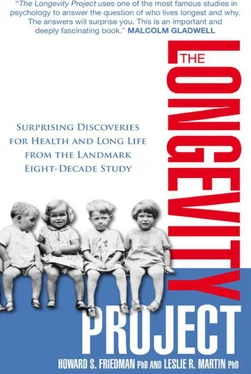In American society today, about half of all first marriages end in divorce; the rates of divorce for second and third marriages climb even higher. This rate is higher than it was when the Terman subjects were children. For those whose parents divorced, there was more stigma and more uncertainty, whereas today’s children of divorce are rarely stigmatized and likely have friends in the same situation. In some communities, complete and stable family units in fact seem to be aberrations. Yet even when divorce is the norm, research studies today still find that it is traumatic and harmful to children—in terms of their mental health, in terms of their potential for drug abuse, and more. In this sense, contemporary youth is not so different from the Terman kids—leading us to believe, from our reading of the evidence, that family breakups today are not just an economic threat and a threat to the short-term well-being of children and teenagers, but they can also be a threat to long-term health and well-being.
The good news, on the other hand, is that the risk from parental divorce is not inevitable. Children like Patricia and James, who are not plunged into poverty and who do not turn to harmful habits such as smoking to help them cope or fit in with peers, can dodge the risk. In particular, those who are later able to establish a stable and meaningful relationship with a partner and who find passion and fulfillment in their work can overcome the legacy of divorce. As we shall see in later chapters, the Terman participants showed us the paths on which emotional healing can be found and how old wounds can be put to rest.
SELF-ASSESSMENT: LIFE SATISFACTION
Answer each of the following questions as honestly as you can.
1. Which of the following best describes your feeling about your present vocation?
Deep satisfaction and interest in my work __ (5)
Fairly content __ (4)
No serious discontent, but don’t find it especially interesting or satisfying __ (3)
Discontented but will probably stick it out __ (2)
Strongly dislike and hope to change __ (1)
2. On the whole, how well do you think you have lived up to your intellectual abilities and potential? (Don’t limit your answer to economic or vocational success only.)
Fully—have been reaching my potential _____ (5)
Reasonably well __ (4)
Considerably short of it __ (3)
Consider my accomplishments __ (2)
Pretty much a failure __ (1)
3. Which of the following best describes your satisfaction with your everyday life?
Love every aspect of it __ (5)
Am satisfied and content with most aspects __ (4)
It has a balance of good and bad __ (3)
I have little to look forward to each day __ (2)
Dislike most aspects of it __ (1)
4. In all, do you feel you are where you should be in fulfilling the plans and dreams you have for your life?
Absolutely __ (5)
For the most part, yes __ (4)
In some areas yes, but not in others __ (3)
For the most part, no __ (2)
Not at all __ (1)
5. If you were to start your life over again, which would be your approach?
I wouldn’t change a thing __ (5)
I would change very little __ (4)
I would make some moderate changes __ (3)
I would probably change many things __ (2)
I would change almost all of it __ (1)
6. Which of the following best describes your contentment with your social life?
Completely content, it’s just right __ (5)
Quite content, I’m seldom lonely or overwhelmed with too many activities __ (4)
Neither content nor otherwise __ (3)
Quite discontented, I’m often too lonely or am overwhelmed with excessive socializing __ (2)
Completely discontented, it’s not at all what I would prefer __ (1)
Scoring: Each of the questions has five options, and they are listed in descending order with regard to satisfaction—that is, the first response for each question indicates the greatest satisfaction and receives a score of 5 and the last response indicates the least and receives a score of 1. Add up the total. Your score should fall between 6 and 30. If you scored at least 20 you are in the upper quartile (25 percent) in terms of being satisfied with your life. The lower quartile scores around 15 and below.
For those who endured the trauma of their parents’ divorce, having gained a sense of competence, maturity, and satisfaction in adulthood are very good signs that one has bounced back from the stress one bore. For those who faced parental divorce and have a low score on satisfaction with life and accomplishments, this combination could be a warning sign of health risks to come. But it is only one sign, and it should be considered in the context of the other risk factors we’ll be describing.
What It Means for You: Guideposts to Health and Long Life
Parents sometimes wisecrack that they sleep in separate bedrooms, keep separate checking accounts, and take separate vacations—anything to keep their marriage together. But divorce is no joke to the children. Our studies revealed that the stress of family discord and especially parental divorce is important not only in the short term but to a person’s entire life path. Fortunately, we also uncovered a little-explored route off the main highway—a road toward resilience.
We found no long-term health effects coming from the early death of a parent. Instead, it was the conflict and stress of a disintegrating family that proved to be problematic. The children who lived through ongoing clashes and those who were shocked by a seemingly sudden split took things especially badly. Many turned to unhealthy behaviors like smoking and headed down unhealthy pathways in which they did not reach their educational and career potential.
That said, the Terman participants who were able, despite the dysfunctional patterns they observed in childhood, to establish themselves in good marriages of their own were much better off in terms of their future health and longevity than were those who followed the template their parents modeled for them. Most important, achieving a sense of satisfaction and a sense of accomplishment by young adulthood had a valuable buffering effect. These mature individuals had strengthened themselves and embarked on the path to long life.
Patricia and James were both able to develop these resilient patterns, perhaps learning from their parents’ mistakes and resolving to do differently in their own lives. Sure, they did the right things in other ways, too, by trying to avoid unhealthy habits and by persevering toward their educational and career goals. But through their deeper patterns of living—toward satisfaction in life and good marriages—they were able to thrive despite the challenges they encountered. In other words, having one’s parents split up does not necessarily mean increased health risks for an individual, but rather it may make working at one’s own situation particularly important, with correspondingly greater benefits.
CHAPTER 8
Running for Their Lives
Jocks vs. Nerds
Ancel Keys was a very active man. One of the publicly identified Terman study participants, Keys became world famous in public health. Most people know of his work even if they do not know his name. Ancel Keys was also one of the longest living Terman subjects. As a toddler, he survived the San Francisco earthquake of 1906. After a very long and eventful life, he died in 2004, at the age of one hundred.
As a young man Ancel worked first in a lumber camp, and then as a gold miner, a ship’s oiler, a manager, and a scientist. After receiving his doctorate in biology, he continued to travel ardently, even going to the Chilean Andes to study the physiological effects of high altitudes. Keys was the nephew of actor Lon Chaney but that was not his claim to fame. He is notable for his work on fats, cholesterol, and heart disease.
Читать дальше











